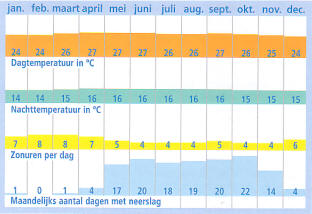CLIMATE
In general, one can say that Costa Rica has a subtropical to tropical climate with a dry season from December to April and a wet season from May to November. Due to its location near the equator, there are hardly any temperature differences at sea level. Costa Rica can therefore be visited all year round.
The temperature differences between the hottest and the coldest month do not exceed 4 °C. The annual averages are at the coast at 26 to 27°C, at an altitude of 1000 m at approx. 20°C and at an altitude of 3000 m at 7 to 8°C.
The average annual precipitation amounts fluctuate between a minimum of 2000 mm and a maximum of 4000 mm. Along the Caribbean coast, strongly influenced by trade winds and depressions on the Atlantic Ocean, quite a lot of rain falls throughout the year in the form of tropical downpours; more than 3000 mm on average and in the Barra del Colorado reservation in the north more than 6000 mm. Sometimes in a given year there is between 8000 and 9000 mm. September and October are the driest months here.
The area along the Pacific coast has a dry and a wet season. In the northwest there is 'only' between 1000-2000 mm per year ('tierra caliente') and between December and April there is hardly any precipitation and it is very dry, hot and sunny. This is because the entire area is then in the rain shadow of the mountain ranges.
Between 600 and 1650 meters lies the temperate zone or 'tierra templada', including the Meseta Central with the capital San José. The average minimum temperature there is 16.3°C and the average maximum temperature is 24.9°C. The annual precipitation is between 1600 and 2000 mm.
The areas between 2000 and 3300 meters form the 'tierra fría', with temperatures ranging from 10 to 16°C, especially in the higher parts of the Cordillera Central and the Cordillera de Talamanca. On the high peaks of the Cerro Chirripó and the volcano Irazú the average temperature does not exceed 7°C. However, snow rarely falls, but temperatures can drop below freezing.
The hurricanes that move across the Caribbean from the Atlantic usually pass through Costa Rica along its northern border. As a result, compared to a number of neighboring countries, the country has relatively little to do with natural disasters. However, flooding does occasionally occur in the lower-lying areas during the rainy season.
The dry season (verano) is the high season in the tourist sector. Prices are also considerably higher in high season, especially for the hotels on the coast. The rainy season (invierno) is also called the green season in Costa Rica so as not to scare off tourists by the term rainy season. In the rainy season there is a tropical shower in the afternoon for an hour. In the beginning and at the end of the rainy season it wants to rain a little longer. But the sun also shines for at least 6 hours a day in this season. In the dry season, the sun shines an average of 9 hours a day.

Weather in San Jose


